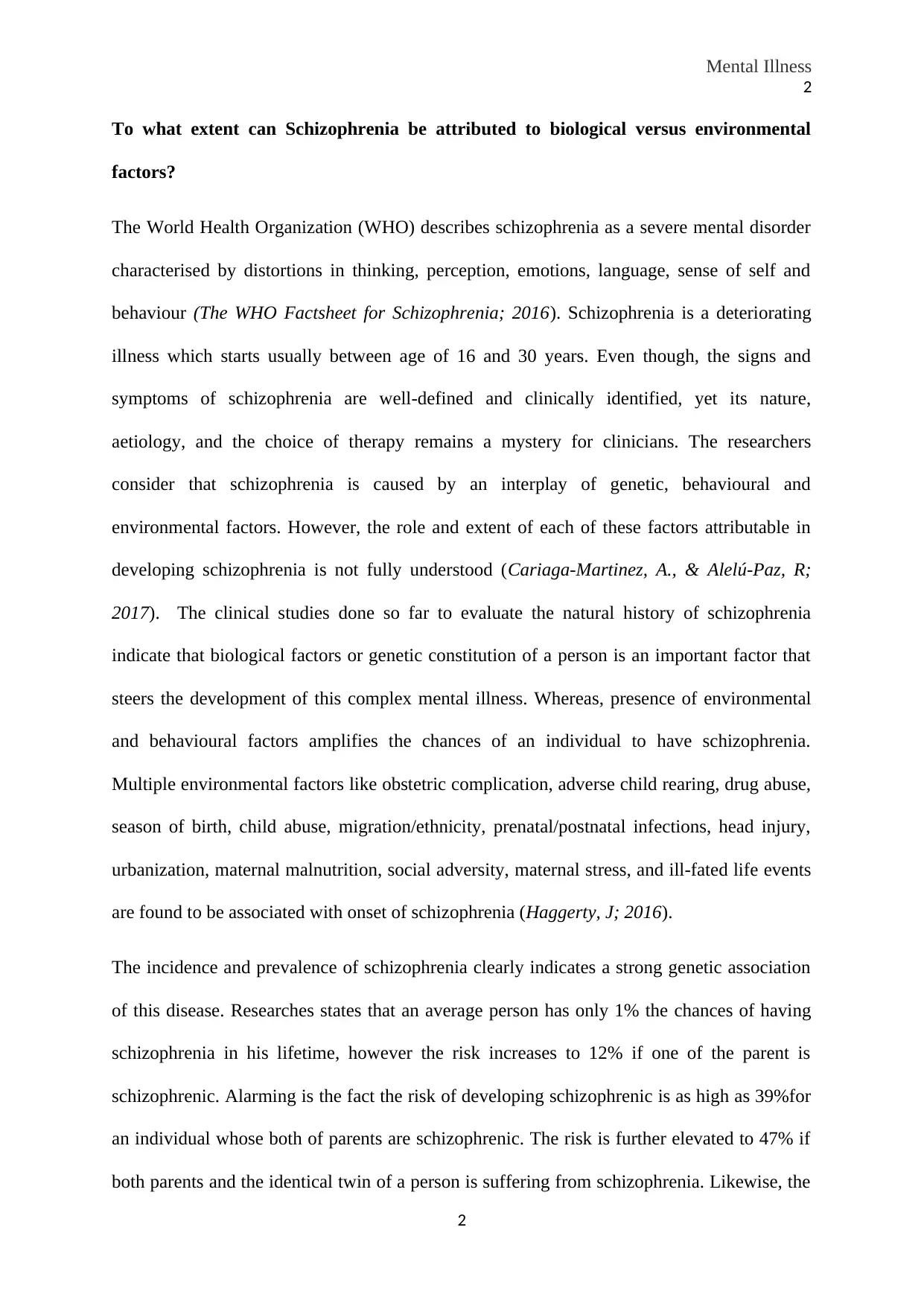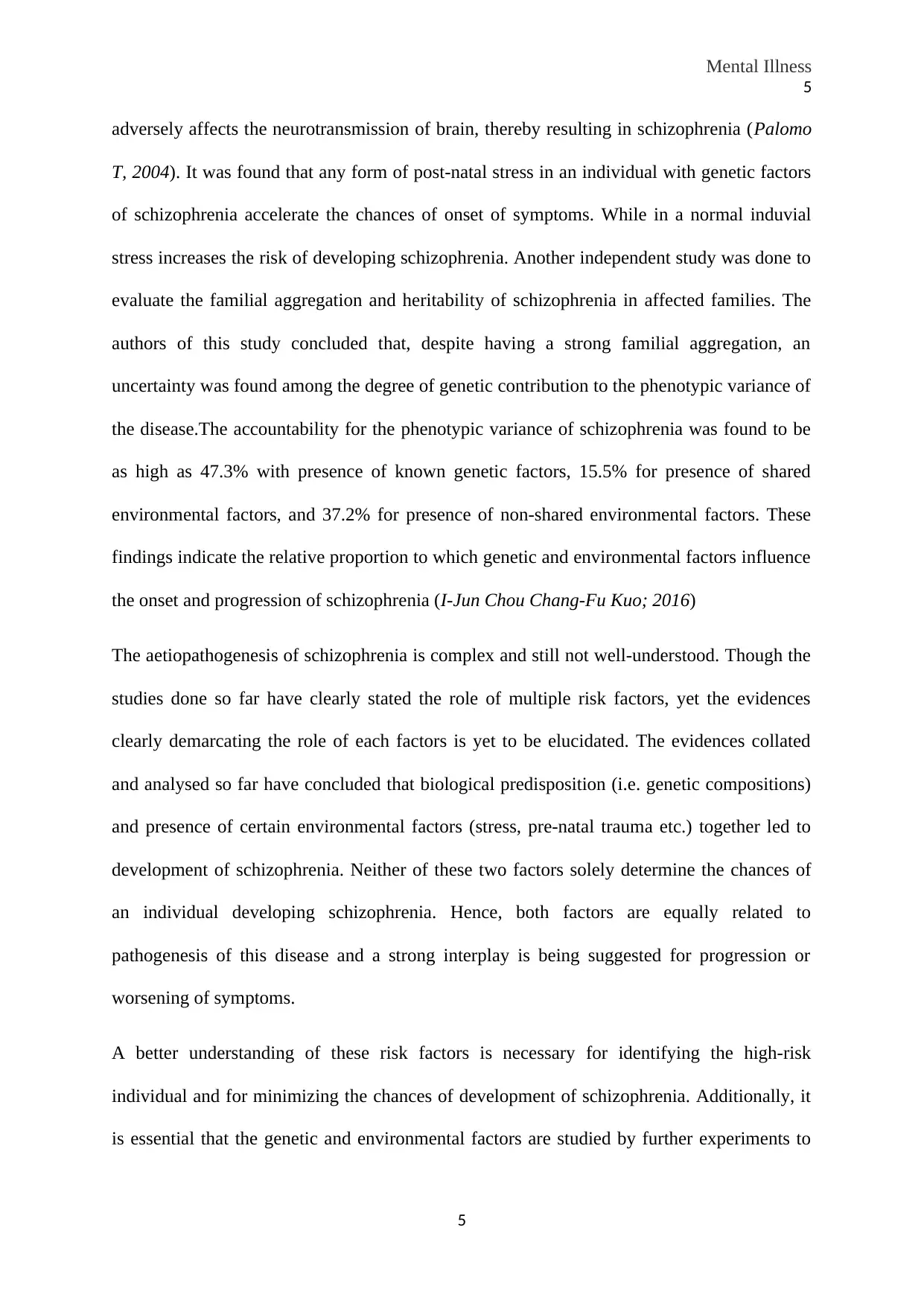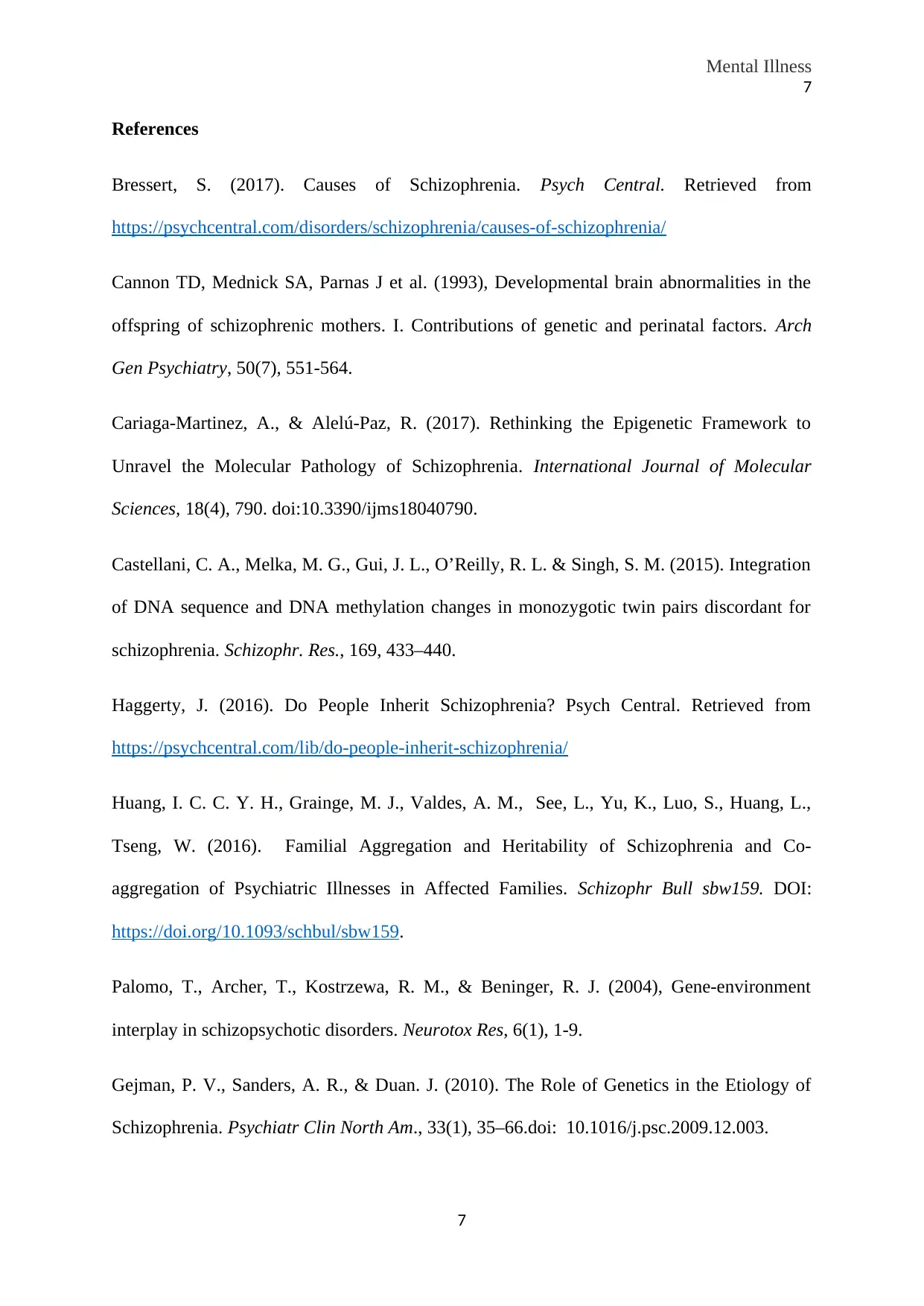The Etiology of Schizophrenia: Nature vs. Nurture Debate
VerifiedAdded on 2019/12/04
|8
|1856
|289
Essay
AI Summary
This essay explores the complex etiology of schizophrenia, examining the relative contributions of biological and environmental factors. The World Health Organization (WHO) defines schizophrenia as a severe mental disorder marked by distortions in thinking, perception, emotions, and behavior. While genetic factors, such as family history and twin studies, strongly suggest a biological predisposition, environmental factors like obstetric complications, stress, and prenatal events also play a significant role. The essay reviews research highlighting the interplay of genetic polymorphisms, environmental stressors, and developmental brain abnormalities. Adoption studies and genomic-wide association studies (GWAS) further illustrate the intricate relationship between nature and nurture. The conclusion emphasizes that neither factor alone fully determines the likelihood of developing schizophrenia; rather, a complex interaction between biological predisposition and environmental influences is central to the disease's pathogenesis. Further research is crucial for identifying high-risk individuals and developing improved therapeutic strategies.

Mental Illness
1
Mental Illness
Student's Name:
Instructor's Name:
Date:
1
1
Mental Illness
Student's Name:
Instructor's Name:
Date:
1
Paraphrase This Document
Need a fresh take? Get an instant paraphrase of this document with our AI Paraphraser

Mental Illness
2
To what extent can Schizophrenia be attributed to biological versus environmental
factors?
The World Health Organization (WHO) describes schizophrenia as a severe mental disorder
characterised by distortions in thinking, perception, emotions, language, sense of self and
behaviour (The WHO Factsheet for Schizophrenia; 2016). Schizophrenia is a deteriorating
illness which starts usually between age of 16 and 30 years. Even though, the signs and
symptoms of schizophrenia are well-defined and clinically identified, yet its nature,
aetiology, and the choice of therapy remains a mystery for clinicians. The researchers
consider that schizophrenia is caused by an interplay of genetic, behavioural and
environmental factors. However, the role and extent of each of these factors attributable in
developing schizophrenia is not fully understood (Cariaga-Martinez, A., & Alelú-Paz, R;
2017). The clinical studies done so far to evaluate the natural history of schizophrenia
indicate that biological factors or genetic constitution of a person is an important factor that
steers the development of this complex mental illness. Whereas, presence of environmental
and behavioural factors amplifies the chances of an individual to have schizophrenia.
Multiple environmental factors like obstetric complication, adverse child rearing, drug abuse,
season of birth, child abuse, migration/ethnicity, prenatal/postnatal infections, head injury,
urbanization, maternal malnutrition, social adversity, maternal stress, and ill-fated life events
are found to be associated with onset of schizophrenia (Haggerty, J; 2016).
The incidence and prevalence of schizophrenia clearly indicates a strong genetic association
of this disease. Researches states that an average person has only 1% the chances of having
schizophrenia in his lifetime, however the risk increases to 12% if one of the parent is
schizophrenic. Alarming is the fact the risk of developing schizophrenic is as high as 39%for
an individual whose both of parents are schizophrenic. The risk is further elevated to 47% if
both parents and the identical twin of a person is suffering from schizophrenia. Likewise, the
2
2
To what extent can Schizophrenia be attributed to biological versus environmental
factors?
The World Health Organization (WHO) describes schizophrenia as a severe mental disorder
characterised by distortions in thinking, perception, emotions, language, sense of self and
behaviour (The WHO Factsheet for Schizophrenia; 2016). Schizophrenia is a deteriorating
illness which starts usually between age of 16 and 30 years. Even though, the signs and
symptoms of schizophrenia are well-defined and clinically identified, yet its nature,
aetiology, and the choice of therapy remains a mystery for clinicians. The researchers
consider that schizophrenia is caused by an interplay of genetic, behavioural and
environmental factors. However, the role and extent of each of these factors attributable in
developing schizophrenia is not fully understood (Cariaga-Martinez, A., & Alelú-Paz, R;
2017). The clinical studies done so far to evaluate the natural history of schizophrenia
indicate that biological factors or genetic constitution of a person is an important factor that
steers the development of this complex mental illness. Whereas, presence of environmental
and behavioural factors amplifies the chances of an individual to have schizophrenia.
Multiple environmental factors like obstetric complication, adverse child rearing, drug abuse,
season of birth, child abuse, migration/ethnicity, prenatal/postnatal infections, head injury,
urbanization, maternal malnutrition, social adversity, maternal stress, and ill-fated life events
are found to be associated with onset of schizophrenia (Haggerty, J; 2016).
The incidence and prevalence of schizophrenia clearly indicates a strong genetic association
of this disease. Researches states that an average person has only 1% the chances of having
schizophrenia in his lifetime, however the risk increases to 12% if one of the parent is
schizophrenic. Alarming is the fact the risk of developing schizophrenic is as high as 39%for
an individual whose both of parents are schizophrenic. The risk is further elevated to 47% if
both parents and the identical twin of a person is suffering from schizophrenia. Likewise, the
2

Mental Illness
3
risk is 8% if one of the sibling is schizophrenic, while it is 14% if one has a schizophrenic
fraternal twin(Haggerty, J; 2016). A recent clinical study also stated that the inheritability of
schizophrenia for monozygotic twins is about 80%, with a high concordance rates of about
40–50% (Castellani, C.A.; 2015). The findings of this study and the previously described
statics clearly indicates that genetic factor is by far the most important regulating factor for
development of schizophrenia.
Contradicting to these findings, the adoption studies shows that environmental factors also
significantly involved in onset of schizophrenia. It was found in these studies that there is an
elevated risk for psychosis in offspring adopted by schizophrenic parents, similar findings
were observed with individual with schizophrenic foster parents (Gejman PV, 2009). Another
study stated that the risk of transmission of schizophrenia was similar among offspring of
schizophrenia mothers, whether they were raised by the biological (schizophrenic) parent or
an adoptive (non-schizophrenic) parent. These findings indicate that irrespective of the
genomic make-up of an individual the risk of developing schizophrenia can be altered by
modifying the environmental factors of the disease.
A genetic study done to describe the aetiology of schizophrenia suggested thatthe 677C—>T
polymorphism is present at higher levels in patients with schizophrenia than the general
population. However, the further studies done to elucidate failed to replicate the finding of
this study (Regland B; 1997).
The recent genomic-wide association studies (GWAS) were the largest set of studies done to
evaluate the nature and extent of association of genetic polymorphism with schizophrenia. the
study compared the genomes of 37,000 schizophrenics against 113,000 healthy individuals.
The findings of this study revealed 128 genome wide significant single nucleotide
polymorphisms (SNP) and 108 genome wide loci in schizophrenic individuals. Additionally,
3
3
risk is 8% if one of the sibling is schizophrenic, while it is 14% if one has a schizophrenic
fraternal twin(Haggerty, J; 2016). A recent clinical study also stated that the inheritability of
schizophrenia for monozygotic twins is about 80%, with a high concordance rates of about
40–50% (Castellani, C.A.; 2015). The findings of this study and the previously described
statics clearly indicates that genetic factor is by far the most important regulating factor for
development of schizophrenia.
Contradicting to these findings, the adoption studies shows that environmental factors also
significantly involved in onset of schizophrenia. It was found in these studies that there is an
elevated risk for psychosis in offspring adopted by schizophrenic parents, similar findings
were observed with individual with schizophrenic foster parents (Gejman PV, 2009). Another
study stated that the risk of transmission of schizophrenia was similar among offspring of
schizophrenia mothers, whether they were raised by the biological (schizophrenic) parent or
an adoptive (non-schizophrenic) parent. These findings indicate that irrespective of the
genomic make-up of an individual the risk of developing schizophrenia can be altered by
modifying the environmental factors of the disease.
A genetic study done to describe the aetiology of schizophrenia suggested thatthe 677C—>T
polymorphism is present at higher levels in patients with schizophrenia than the general
population. However, the further studies done to elucidate failed to replicate the finding of
this study (Regland B; 1997).
The recent genomic-wide association studies (GWAS) were the largest set of studies done to
evaluate the nature and extent of association of genetic polymorphism with schizophrenia. the
study compared the genomes of 37,000 schizophrenics against 113,000 healthy individuals.
The findings of this study revealed 128 genome wide significant single nucleotide
polymorphisms (SNP) and 108 genome wide loci in schizophrenic individuals. Additionally,
3
⊘ This is a preview!⊘
Do you want full access?
Subscribe today to unlock all pages.

Trusted by 1+ million students worldwide

Mental Illness
4
structural variations such as microdeletions and microduplications were also identified in a
subgroup of patients. The microdeletions were identified on 1q21.1, 2p16.3, 3q29, 15q13.3
and 16p11.2 as well as a large deletion were on 22q11.21 and a single microduplication on
16p11.2. These findings provide substantial evidences about the role of genetic factors in
development of schizophrenia. However, further studies are recommended to find out the
exact genes which are responsible for onset and progression of this mental illness
(Schizophrenia Working Group of the Psychiatric Genomics Consortium, 2014).The major
limitations of the GWAS studies was the high chances of getting false positive results due to
complex methodology involved. Secondly, the interplay of other factors, particularly
environmental factors were not studied, which might have influenced the overall findings.
As stated earlier, several environmental factors are found to be strongly associated with
schizophrenia or psychosis. The risk of schizophrenia is significantly increased among the
new-borns who are exposed to maternal infection like rubella and respiratory infections, born
under low socioeconomic class, have significant maternal deprivation due to natural calamity
like famine or man-made calamity like war/ riots, obstetric complications, and are born in late
winter/early spring.
A few studies are done which compared the influence of both genetic and environment
factors parallelly in individuals with schizophrenia. A study was done to compare the role of
genetic factors and environmental factors in development of schizophrenia later in life. The
findings of this study showed that foetal hypoxia or pre-natal insult results in decrease in
mass of grey matter and reduced volume of cerebrospinal fluid in foetus brain. New-borns
exposed to such pre-natal events are at high risk of developing schizophrenia irrespective of
their healthy genetic constitution and no family history of schizophrenia(Cannon TD, 1993).
As mentioned earlier, stress is another environmental factor which pre-disposes an individual
with normal genetics to schizophrenia. Stress produces glutamate and dopamine which
4
4
structural variations such as microdeletions and microduplications were also identified in a
subgroup of patients. The microdeletions were identified on 1q21.1, 2p16.3, 3q29, 15q13.3
and 16p11.2 as well as a large deletion were on 22q11.21 and a single microduplication on
16p11.2. These findings provide substantial evidences about the role of genetic factors in
development of schizophrenia. However, further studies are recommended to find out the
exact genes which are responsible for onset and progression of this mental illness
(Schizophrenia Working Group of the Psychiatric Genomics Consortium, 2014).The major
limitations of the GWAS studies was the high chances of getting false positive results due to
complex methodology involved. Secondly, the interplay of other factors, particularly
environmental factors were not studied, which might have influenced the overall findings.
As stated earlier, several environmental factors are found to be strongly associated with
schizophrenia or psychosis. The risk of schizophrenia is significantly increased among the
new-borns who are exposed to maternal infection like rubella and respiratory infections, born
under low socioeconomic class, have significant maternal deprivation due to natural calamity
like famine or man-made calamity like war/ riots, obstetric complications, and are born in late
winter/early spring.
A few studies are done which compared the influence of both genetic and environment
factors parallelly in individuals with schizophrenia. A study was done to compare the role of
genetic factors and environmental factors in development of schizophrenia later in life. The
findings of this study showed that foetal hypoxia or pre-natal insult results in decrease in
mass of grey matter and reduced volume of cerebrospinal fluid in foetus brain. New-borns
exposed to such pre-natal events are at high risk of developing schizophrenia irrespective of
their healthy genetic constitution and no family history of schizophrenia(Cannon TD, 1993).
As mentioned earlier, stress is another environmental factor which pre-disposes an individual
with normal genetics to schizophrenia. Stress produces glutamate and dopamine which
4
Paraphrase This Document
Need a fresh take? Get an instant paraphrase of this document with our AI Paraphraser

Mental Illness
5
adversely affects the neurotransmission of brain, thereby resulting in schizophrenia (Palomo
T, 2004). It was found that any form of post-natal stress in an individual with genetic factors
of schizophrenia accelerate the chances of onset of symptoms. While in a normal induvial
stress increases the risk of developing schizophrenia. Another independent study was done to
evaluate the familial aggregation and heritability of schizophrenia in affected families. The
authors of this study concluded that, despite having a strong familial aggregation, an
uncertainty was found among the degree of genetic contribution to the phenotypic variance of
the disease.The accountability for the phenotypic variance of schizophrenia was found to be
as high as 47.3% with presence of known genetic factors, 15.5% for presence of shared
environmental factors, and 37.2% for presence of non-shared environmental factors. These
findings indicate the relative proportion to which genetic and environmental factors influence
the onset and progression of schizophrenia (I-Jun Chou Chang-Fu Kuo; 2016)
The aetiopathogenesis of schizophrenia is complex and still not well-understood. Though the
studies done so far have clearly stated the role of multiple risk factors, yet the evidences
clearly demarcating the role of each factors is yet to be elucidated. The evidences collated
and analysed so far have concluded that biological predisposition (i.e. genetic compositions)
and presence of certain environmental factors (stress, pre-natal trauma etc.) together led to
development of schizophrenia. Neither of these two factors solely determine the chances of
an individual developing schizophrenia. Hence, both factors are equally related to
pathogenesis of this disease and a strong interplay is being suggested for progression or
worsening of symptoms.
A better understanding of these risk factors is necessary for identifying the high-risk
individual and for minimizing the chances of development of schizophrenia. Additionally, it
is essential that the genetic and environmental factors are studied by further experiments to
5
5
adversely affects the neurotransmission of brain, thereby resulting in schizophrenia (Palomo
T, 2004). It was found that any form of post-natal stress in an individual with genetic factors
of schizophrenia accelerate the chances of onset of symptoms. While in a normal induvial
stress increases the risk of developing schizophrenia. Another independent study was done to
evaluate the familial aggregation and heritability of schizophrenia in affected families. The
authors of this study concluded that, despite having a strong familial aggregation, an
uncertainty was found among the degree of genetic contribution to the phenotypic variance of
the disease.The accountability for the phenotypic variance of schizophrenia was found to be
as high as 47.3% with presence of known genetic factors, 15.5% for presence of shared
environmental factors, and 37.2% for presence of non-shared environmental factors. These
findings indicate the relative proportion to which genetic and environmental factors influence
the onset and progression of schizophrenia (I-Jun Chou Chang-Fu Kuo; 2016)
The aetiopathogenesis of schizophrenia is complex and still not well-understood. Though the
studies done so far have clearly stated the role of multiple risk factors, yet the evidences
clearly demarcating the role of each factors is yet to be elucidated. The evidences collated
and analysed so far have concluded that biological predisposition (i.e. genetic compositions)
and presence of certain environmental factors (stress, pre-natal trauma etc.) together led to
development of schizophrenia. Neither of these two factors solely determine the chances of
an individual developing schizophrenia. Hence, both factors are equally related to
pathogenesis of this disease and a strong interplay is being suggested for progression or
worsening of symptoms.
A better understanding of these risk factors is necessary for identifying the high-risk
individual and for minimizing the chances of development of schizophrenia. Additionally, it
is essential that the genetic and environmental factors are studied by further experiments to
5

Mental Illness
6
find out their exact association with the disease which could later help the clinicians to find
better therapeutic options for prevention, timely diagnosis and management of schizophrenia.
6
6
find out their exact association with the disease which could later help the clinicians to find
better therapeutic options for prevention, timely diagnosis and management of schizophrenia.
6
⊘ This is a preview!⊘
Do you want full access?
Subscribe today to unlock all pages.

Trusted by 1+ million students worldwide

Mental Illness
7
References
Bressert, S. (2017). Causes of Schizophrenia. Psych Central. Retrieved from
https://psychcentral.com/disorders/schizophrenia/causes-of-schizophrenia/
Cannon TD, Mednick SA, Parnas J et al. (1993), Developmental brain abnormalities in the
offspring of schizophrenic mothers. I. Contributions of genetic and perinatal factors. Arch
Gen Psychiatry, 50(7), 551-564.
Cariaga-Martinez, A., & Alelú-Paz, R. (2017). Rethinking the Epigenetic Framework to
Unravel the Molecular Pathology of Schizophrenia. International Journal of Molecular
Sciences, 18(4), 790. doi:10.3390/ijms18040790.
Castellani, C. A., Melka, M. G., Gui, J. L., O’Reilly, R. L. & Singh, S. M. (2015). Integration
of DNA sequence and DNA methylation changes in monozygotic twin pairs discordant for
schizophrenia. Schizophr. Res., 169, 433–440.
Haggerty, J. (2016). Do People Inherit Schizophrenia? Psych Central. Retrieved from
https://psychcentral.com/lib/do-people-inherit-schizophrenia/
Huang, I. C. C. Y. H., Grainge, M. J., Valdes, A. M., See, L., Yu, K., Luo, S., Huang, L.,
Tseng, W. (2016). Familial Aggregation and Heritability of Schizophrenia and Co-
aggregation of Psychiatric Illnesses in Affected Families. Schizophr Bull sbw159. DOI:
https://doi.org/10.1093/schbul/sbw159.
Palomo, T., Archer, T., Kostrzewa, R. M., & Beninger, R. J. (2004), Gene-environment
interplay in schizopsychotic disorders. Neurotox Res, 6(1), 1-9.
Gejman, P. V., Sanders, A. R., & Duan. J. (2010). The Role of Genetics in the Etiology of
Schizophrenia. Psychiatr Clin North Am., 33(1), 35–66.doi: 10.1016/j.psc.2009.12.003.
7
7
References
Bressert, S. (2017). Causes of Schizophrenia. Psych Central. Retrieved from
https://psychcentral.com/disorders/schizophrenia/causes-of-schizophrenia/
Cannon TD, Mednick SA, Parnas J et al. (1993), Developmental brain abnormalities in the
offspring of schizophrenic mothers. I. Contributions of genetic and perinatal factors. Arch
Gen Psychiatry, 50(7), 551-564.
Cariaga-Martinez, A., & Alelú-Paz, R. (2017). Rethinking the Epigenetic Framework to
Unravel the Molecular Pathology of Schizophrenia. International Journal of Molecular
Sciences, 18(4), 790. doi:10.3390/ijms18040790.
Castellani, C. A., Melka, M. G., Gui, J. L., O’Reilly, R. L. & Singh, S. M. (2015). Integration
of DNA sequence and DNA methylation changes in monozygotic twin pairs discordant for
schizophrenia. Schizophr. Res., 169, 433–440.
Haggerty, J. (2016). Do People Inherit Schizophrenia? Psych Central. Retrieved from
https://psychcentral.com/lib/do-people-inherit-schizophrenia/
Huang, I. C. C. Y. H., Grainge, M. J., Valdes, A. M., See, L., Yu, K., Luo, S., Huang, L.,
Tseng, W. (2016). Familial Aggregation and Heritability of Schizophrenia and Co-
aggregation of Psychiatric Illnesses in Affected Families. Schizophr Bull sbw159. DOI:
https://doi.org/10.1093/schbul/sbw159.
Palomo, T., Archer, T., Kostrzewa, R. M., & Beninger, R. J. (2004), Gene-environment
interplay in schizopsychotic disorders. Neurotox Res, 6(1), 1-9.
Gejman, P. V., Sanders, A. R., & Duan. J. (2010). The Role of Genetics in the Etiology of
Schizophrenia. Psychiatr Clin North Am., 33(1), 35–66.doi: 10.1016/j.psc.2009.12.003.
7
Paraphrase This Document
Need a fresh take? Get an instant paraphrase of this document with our AI Paraphraser

Mental Illness
8
Regland, B., Germgard, T., Gottfries, C. G. et al. (1997). Homozygous thermolabile
methylenetetrahydrofolate reductase in schizophrenia-like psychosis. J Neural Transm,
104(8-9):931-941. DOI: 10.1007/BF01285561.
Schizophrenia Working Group of the Psychiatric Genomics Consortium. (2014). Biological
insights from 108 schizophrenia-associated genetic loci. Nature, 511(7510), 421-427. doi:
10.1038/nature13595.
The WHO Factsheet for Schizophrenia (2016). Retrieved from
http://www.who.int/mediacentre/factsheets/fs397/en/
8
8
Regland, B., Germgard, T., Gottfries, C. G. et al. (1997). Homozygous thermolabile
methylenetetrahydrofolate reductase in schizophrenia-like psychosis. J Neural Transm,
104(8-9):931-941. DOI: 10.1007/BF01285561.
Schizophrenia Working Group of the Psychiatric Genomics Consortium. (2014). Biological
insights from 108 schizophrenia-associated genetic loci. Nature, 511(7510), 421-427. doi:
10.1038/nature13595.
The WHO Factsheet for Schizophrenia (2016). Retrieved from
http://www.who.int/mediacentre/factsheets/fs397/en/
8
1 out of 8
Related Documents
Your All-in-One AI-Powered Toolkit for Academic Success.
+13062052269
info@desklib.com
Available 24*7 on WhatsApp / Email
![[object Object]](/_next/static/media/star-bottom.7253800d.svg)
Unlock your academic potential
Copyright © 2020–2025 A2Z Services. All Rights Reserved. Developed and managed by ZUCOL.





